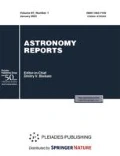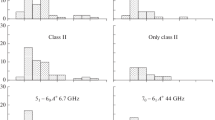Abstract
The excitation of methanol in the absence of external radiation is analyzed, and LTE methods for probing interstellar gas considered. It is shown that rotation diagrams correctly estimate the gas kinetic temperature only if they are constructed using lines whose upper levels are located in the same K-ladders, such as the J 0−J −1 E lines at 157 GHz, the J 1−J 0 E lines at 165 GHz, and the J 2−J 1 E lines at 25 GHz. The gas density must be no less than 107 cm−3. Rotation diagrams constructed from lines with different K values for their upper levels (e.g., 2 K −1 K at 96 GHz, 3 K −2 K at 145 GHz, 5 K −4 K at 241 GHz) significantly underestimate the temperature, but enable estimation of the density. In addition, diagrams based on the 2 K −1 K lines can be used to estimate the methanol column density within a factor of about two to five. It is suggested that rotation diagrams should be used in the following manner. First, two rotation diagrams should be constructed, one from the lines at 96, 145, or 241 GHz, and another from the lines at 157, 165, or 25 GHz. The former diagram is used to estimate the gas density. If the density is about 107 cm−3 or higher, the latter diagram reproduces the temperature fairly well. If the density is around 106 cm−3, the temperature obtained from the latter diagram should be multiplied by a factor of 1.5–2. If the density is about 105 cm−3 or lower, then the latter diagram yields a temperature that is lower than the kinetic temperature by a factor of three or more, and should be used only as a lower limit for the kinetic temperature. The errors in the methanol column density determined from the integrated intensity of a single line can be more than an order of magnitude, even when the gas temperature is well known. However, if the J 0−(J − 1)0 E lines, as well as the J 1−(J − 1)1 A + or A − lines are used, the relative error in the column density is no more than a factor of a few.
Similar content being viewed by others
References
B. E. Turner, Astrophys. J. 501, 731 (1998).
F. F. S. van der Tak, E. F. van Dishoeck, and P. Caselli, Astron. Astrophys. 361, 327 (2000).
J. T. Pottage, D. R. Flower, and S. L. Davis, J. Phys. B 35, 2541 (2002).
J. T. Pottage, D. R. Flower, and S. L. Davis, Mon. Not. R. Astron. Soc. 352, 39 (2004).
S. V. Kalenskii, A. V. Alakoz, and V. G. Promyslov, in Chemistry as a Diagnostic of Star Formation, Ed. by C. L. Curry and M. Fish (NRCPress,Ottawa, Canada, 2003), Vol. 53, p. 321.
S. Leurini, P. Schilke, K. M. Menten, D. R. Flower, J. T. Pottage, and L.-H. Xu, Astron. Astrophys. 422, 573 (2004).
S. V. Salii, PhD Thesis (Ural State University, Yekaterinburg, 2009).
R. Bachiller, S. Liechti, C. M. Walmsley, and F. S. Colomer, Astron. Astrophys. 295, 51 (1995).
M. Benedettini, S. Viti, C. Codella, M. Benedettini, S. Viti, C. Codella, F. Gueth, A. I. Gómez-Ruiz, R. Bachiller, M. T. Beltrán, G. Busquet, C. Ceccarelli, and B. Lefloch, Mon. Not. R. Astron. Soc. 436, 179 (2013)
C. H. Townes and A. L. Schawlow, Microwave Spectroscopy (Dover, New York, 1975).
R. M. Lees and J. G. Baker, J. Chem. Phys. 48, 5299 (1968).
R. M. Lees, Astrophys. J. 184, 763 (1973).
S. Leurini, P. Schilke, F. Wyrowski, and K. M. Menten, Astron. Astrophys. 466, 215 (2007).
M. Elitzur, Rev. Mod. Phys. 54, 1225 (1982).
F. F. S. van der Tak, J. H. Black, F. L. Schöier, D. J. Jansen, and E. F. van Dishoeck, Astron. Astrophys. 468, 627 (2007).
G. A. Blake, E. C. Sutton, C. R. Masson, and T. G. Phillips, Astrophys. J. 315, 621 (1987).
A. Remijan, E. C. Sutton, L. E. Snyder, D. N. Friedel, S.-Y. Liu, and C.-C. Pei, Astrophys. J. 606, 917 (2004).
P. F. Goldsmith and W. D. Langer, Astrophys. J. 517, 209 (1999).
E. Gibb, A. Nummelin, W. M. Irvine, D. C. Whittet, and P. Bergman, Astrophys. J. 545, 309 (2000).
S. V. Kalenskii, A. M. Dzura, R. S. Booth, A. Winnberg, and A. V. Alakoz, Astron. Astrophys. 321, 311 (1997).
Author information
Authors and Affiliations
Corresponding author
Additional information
Original Russian Text © S.V. Kalenskii, S. Kurtz, 2016, published in Astronomicheskii Zhurnal, 2016, Vol. 93, No. 8, pp. 692–709.
Rights and permissions
About this article
Cite this article
Kalenskii, S.V., Kurtz, S. Analytical methods for measuring the parameters of interstellar gas using methanol observations. Astron. Rep. 60, 702–717 (2016). https://doi.org/10.1134/S1063772916080047
Received:
Accepted:
Published:
Issue Date:
DOI: https://doi.org/10.1134/S1063772916080047



